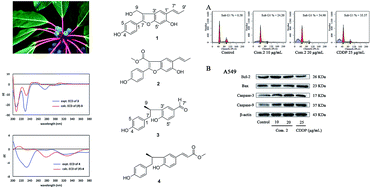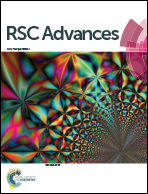Cytotoxic neolignans from the traditional Chinese medicine Daphniphyllum macropodum Miq.†
Abstract
Four new neolignans, (E)-3-(hydroxymethyl)-2-(4-hydroxyphenyl)-5-(prop-1-en-1-yl)benzofuran-6-ol (1), methyl (E)-6-hydroxy-2-(4-hydroxyphenyl)-5-(prop-1-en-1-yl)benzofuran-3-carboxylate (2), (R)-4-hydroxy-3-(1-(4-hydroxyphenyl)propan-2-yl)benzaldehyde (3) and methyl (E,R)-3-(4-hydroxy-3-(1-(4-hydroxyphenyl)propan-2-yl)phenyl)acrylate (4) were isolated from the seeds of Daphniphyllum macropodum Miq, together with four known compounds. The structures of the new compounds were established by spectroscopic analyses, including 1D and 2D NMR as well as HRESIMS data. The absolute configurations of 3 and 4 were determined by the comparison of experimental and calculated electronic circular dichroism (ECD) spectra. All the compounds were evaluated for their antiproliferative activity on human NSCLC A549 and H460 cell lines. Compound 2 significantly inhibited the cancer cell growth in a dose-dependent manner. Mechanism of the action studies showed that 2 increased the expression of bax, caspase-3 and caspase-9, and decreased the production of bcl-2, suggesting that 2 induced apoptosis in A549 cells through activating the mitochondrial pathway.



 Please wait while we load your content...
Please wait while we load your content...